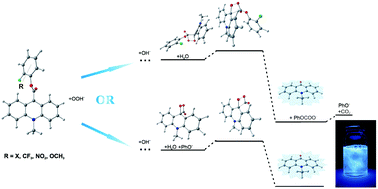Effective chemiluminogenic systems based on acridinium esters bearing substituents of various electronic and steric properties†
Abstract
A series of 10-methyl-9-(phenoxycarbonyl)acridinium trifluoromethanesulfonates (XAEs), bearing substituents of various characteristics in the lateral benzene ring (2-halogen, 2,6-dihalogen, 2-trifluoromethyl, 2-nitro, 2-methoxy, 3-halogen and 4-halogen) were synthesized with high yields, identified and subjected to a physicochemical and theoretical investigation. The main task of the work was to assess the mechanism and optimal conditions of light emission in various liquid systems based on the above salts in order to evaluate their potential usefulness as chemiluminescence (CL) labels and indicators in ultra-sensitive analyses. Density functional theory (DFT) calculations were performed to investigate the detailed mechanism of the oxidation of 9-substituted 10-methylacridinium cations involved in XAEs by hydrogen peroxide in alkaline media. Three general pathways were drawn, which are termed the “light path” (chemiluminogenic) and there were two “dark paths” (non-chemiluminogenic): hydrolytic and “pseudobase”. The CL time profiles, triggered in alkaline solutions containing hydrogen peroxide, enabled us to establish crucial physicochemical parameters, including pseudo-first order kinetic constants of CL decay and relative efficiencies of emission. In order to optimize the systems’ luminogenic performance, different bases, such as sodium hydroxide, tetrabutylammonium hydroxide (TBAOH) and 1,8-diazabicyclo[5.4.0]undec-7-ene (DBU), as well as enhancers, such as cationic, zwitterionic and neutral surfactants (cetyltrimethylammonium chloride (CTAC), N,N-dimethyldodecylammonio-1,3-propane sulfonate (DDAPS) and Triton X-100, respectively) were tested. The results revealed the optimal CL systems, which enabled us to obtain substantially higher emissions than typical ones, based on acridinium esters or luminol. The derived parameters, characterizing the potential utility of the acridinium esters, such as stability in aqueous environments and usefulness (the product of emission efficiency and stability at a given pH), enabled us to reveal the best candidates and their practical applications. The post-reaction mixtures, analyzed by means of chromatography (RP-HPLC) and mass spectrometry (ESI-MS), allowed us to verify the occurrence and population of the products that were theoretically predicted, i.e. 10-methyl-9-acridinone (NMAON), 10-methylacridinium-9-carboxylic acid (NMACA) and substituted phenols (RPhOHs).


 Please wait while we load your content...
Please wait while we load your content...